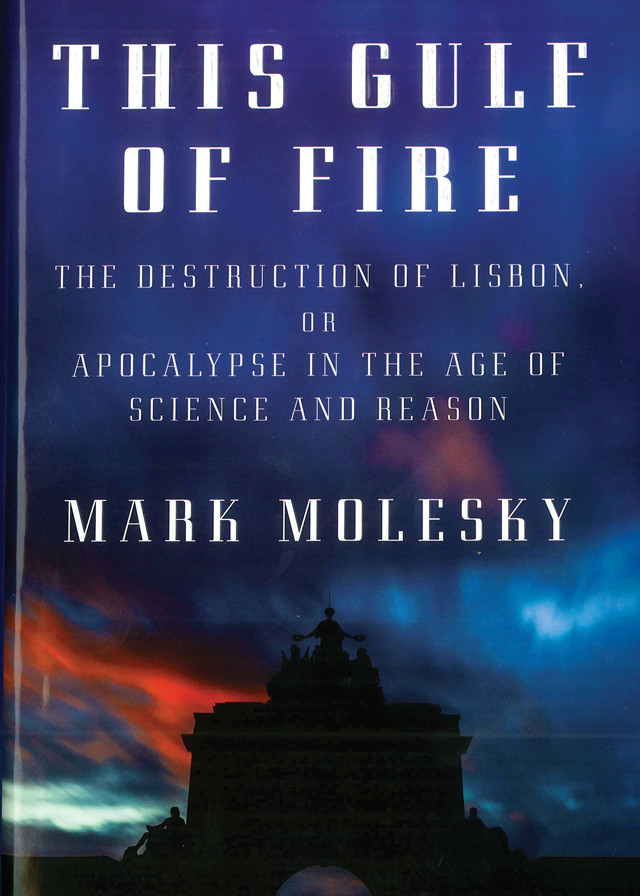
by Callan Bentley Friday, October 12, 2018

"This Gulf of Fire: The Destruction of Lisbon, or Apocalypse in the Age of Science and Reason," by Mark Molesky, Knopf, Hardcover 2015, ISBN-13: 978-0307267627
In the panoply of history-altering natural disasters, Lisbon’s destruction on All Saints’ Day, Nov. 1, 1755, stands out. You may have heard of this Portuguese calamity in the context of tsunami coverage, but it was a sequence of three disasters — an earthquake, a tsunami and a fire — that combined to level much of the city and claim tens of thousands of lives. Some scholars suggest a fourth calamity was the way the aftermath was handled, but author Mark Molesky seems more charitably inclined on that front. In “This Gulf of Fire: The Destruction of Lisbon, or Apocalypse in the Age of Science and Reason,” Molesky, a historian at Seton Hall University in New Jersey, has written the definitive scholarly account — if not the most accessible one — of that fateful day and its historical aftermath.
“This Gulf of Fire” is a comprehensive and impressively researched work with hundreds of citations and 75 pages of footnotes. Molesky seemingly leaves no stone unturned. However, in this attempt to be exhaustive, the book becomes exhausting. Molesky includes every detail, chaff along with wheat, listing, for example, dozens of estimates — ranging from 10,000 to 40,000 — of the death toll from a wealth of sources. In the discussion of death registers from the various churches in the city, there is list after list of names and occupations of those who succumbed. Similarly, there are interminable lists of buildings, streets and other sites that experienced varying degrees of damage. This is doubtless useful material for the historian interested in plotting things out block by block. However, for the nonspecialist reader, especially one who hasn’t visited Lisbon, it is overwhelming. This list mania gets downright silly when Molesky enumerates all the things that burned in the fire: “trunks, dressers, chairs … barrels of fish, gunpowder, butter …” etc. (I’ll spare you the full list.)
But if you skip over many of those lists, you will find a compelling story, with perhaps the most interesting aspect of the disaster being the influence it had on the Enlightenment. The destruction of Lisbon occurred in the middle of this period of flowering of human intellect in a very Catholic city that was one of the last redoubts of the Inquisition. It was a wealthy place, overflowing with riches from Portugal’s colony in Brazil, and attendant levels of indulgence.
Molesky has ready foils to represent both the church and secular forces: the Jesuit priest Gabriel Malagrida and the Marquis of Pombal, an advisor to the king. Like a modern televangelist, Malagrida blames the earthquake on God’s displeasure at the city’s sinful ways to gain followers. Pombal uses the destruction of Lisbon as an opportunity to diminish the influence of the church and advance the cause of secular government, as well as to settle some old scores. He’s a ruthless ruler, and the book opens with him orchestrating the execution of Malagrida. It reads like a scene straight out of “Game of Thrones.”
The tension between religion and reason extended far beyond Portugal’s borders: Across Europe, Lisbon’s apocalypse was a vital prompt for discussion. An entire city had been destroyed by a trio of violent events: What did it mean? Kant, Rousseau, Leibniz and Voltaire all chimed in. Molesky recounts their published discourse in context, and thus furnishes his reader with a sense of the intellectual fallout of the event.
Another bright spot is the book’s illustrations, including maps, that help document conditions on the day of the earthquake, as well as conditions preceding the disaster and during the subsequent reconstruction. Molesky estimates the quake’s magnitude to have been “between 8.5 and perhaps 9.2” and notes that “it was the largest earthquake to affect Europe in the last 10,000 years.” He offers interesting speculation on the source fault for the earthquake and makes the case (for the first time) that the culminating fire qualified as a “firestorm,” a fire so hot and intense that it produced its own wind system. The blaze lasted for weeks and burned the city to its foundations.
If you enjoy European history flavored with tectonic drama, you will likely enjoy “This Gulf of Fire.” And, if you can avoid getting bogged down in the minutiae, you’ll find it offers a rich retelling of an event that could be an exemplar of how societies react to catastrophic natural disasters — complete with lessons to bear in mind when the next great earthquake, tsunami or hurricane strikes.
© 2008-2021. All rights reserved. Any copying, redistribution or retransmission of any of the contents of this service without the expressed written permission of the American Geosciences Institute is expressly prohibited. Click here for all copyright requests.